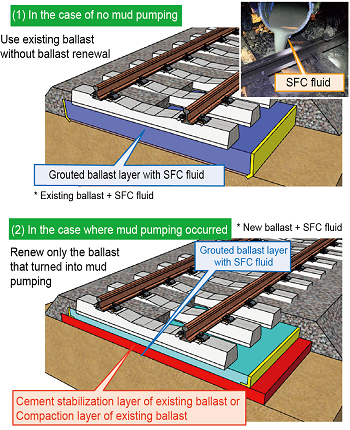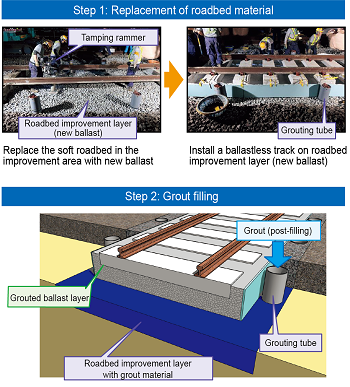15. Low-cost ballastless tracks for existing lines and roadbed improvement method
In order to reduce track maintenance costs, a construction method to convert an existing ballasted track into a ballastless track with low cost is required. As a new elemental technology to address this issue, we have developed the "ballastless track with superfine-particle-cement (SFC) fluid," which utilizes existing ballast, and the "post-filling roadbed improvement method," which can be laid on relatively soft ground.
For the SFC grouted ballastless track, highly permeable superfine-particle-cement fluid, which can be grouted into deteriorated ballast, is used. Normally, the existing ballast is utilized, but if mud pumping occurs, the ballast is grouted after partial ballast renewal (Fig. 1). With this method, the construction cost can be reduced by 40 to 50% compared to the conventional grouted ballasted track that requires renewal of the ballast for the entire track. Especially in mountain tunnel sections where the construction unit price of ballast renewal is relatively high, conversion into a ballastless track with SFC fluid can be achieved at the same cost as ballast renewal. Conversion into a ballastless track with SFC fluid is expected to reduce the maintenance cost in sections where mud pumping of ballast frequently occurs due to the mixture of fine particle soils.
The post-filling roadbed improvement method is to replace the roadbed improvement layer to the new ballast first and then fill the grout material to make the layer more solid later for improving the roadbed to install the ballastless track on soft ground. This can be carried out at the same time as the ballastless track construction (Fig. 2). This makes it possible to install a ballastless track on soft ground even under the condition of a short period of time available for track maintenance. With this method, the construction cost can be reduced by about 60% compared to the conventional roadbed improvement method. In addition, we have proposed a design method that takes the amount of roadbed settlement and fatigue failure of the grouted ballast layer of a ballastless track into account.
These methods will be reflected in the "Guide to Repair and Improvement Methods for Track and Roadbed on Commercial Lines."
Other Contents
- 9. Restoration techniques for embankments reusing collapsed soil
- 10. Structural performance evaluation of existing bridges by acceleration monitoring
- 11. Multi-point synchronous measurement system for railway bridge vibration using a video camera
- 12. Low-cost deterioration evaluation method for the backside ground of slope protection works
- 13. Boring method for constructing a crossing structure under railway tracks making it possible to shorten the construction period
- 14. Maintenance method for prestressed concrete sleepers according to the installation environment
- 15. Low-cost ballastless tracks for existing lines and roadbed improvement method
- 16. The image analysis engine for around track to support train patrol
- 17. Insulator contamination estimation method based on public data
- 18. Degradation evaluation method for lithium-ion batteries for vehicle control circuits
- 9. Restoration techniques for embankments reusing collapsed soil
- 10. Structural performance evaluation of existing bridges by acceleration monitoring
- 11. Multi-point synchronous measurement system for railway bridge vibration using a video camera
- 12. Low-cost deterioration evaluation method for the backside ground of slope protection works
- 13. Boring method for constructing a crossing structure under railway tracks making it possible to shorten the construction period
- 14. Maintenance method for prestressed concrete sleepers according to the installation environment
- 15. Low-cost ballastless tracks for existing lines and roadbed improvement method
- 16. The image analysis engine for around track to support train patrol
- 17. Insulator contamination estimation method based on public data
- 18. Degradation evaluation method for lithium-ion batteries for vehicle control circuits


